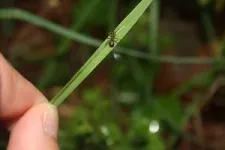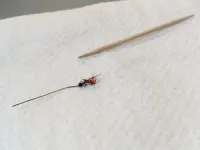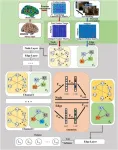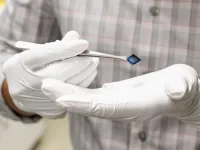(Press-News.org) Imagine coming-to, jaws gripping the top of a swaying blade of grass, unaware of how you got there. That's the reality for ants infected with the lancet liver fluke, a tiny parasitic flatworm. Liver flukes have a complicated, almost insanely conceived life cycle, which begins with the hijacking of the ant’s brain. The unsuspecting ant climbs up and clamps its powerful jaws onto the top of a blade of grass, making it more likely to be eaten by grazers such as cattle and deer.
Researchers from the University of Copenhagen’s Department of Plant and Environmental Sciences have discovered that the parasite's ability to control the ant is even more cunning than previously believed. Impressively, the parasite can even get the ant to crawl back down the blade of grass when it gets too hot.
"Getting the ants high up in the grass for when cattle or deer graze during the cool morning and evening hours, and then down again to avoid the sun’s deadly rays, is quite smart. Our discovery reveals a parasite that is more sophisticated than we originally believed it to be," explains Associate Professor Brian Lund Fredensborg, who conducted the study together with former graduate student Simone Nordstrand Gasque, now a PhD student at Wageningen University in the Netherlands.
The study of the parasite has just been published in the scientific journal Behavoral Ecology
Zombie “on/off switch”
The researchers tagged several hundred infected ants in the Bidstrup Forests near Roskilde, Denmark.
"It took some dexterity to glue colors and numbers onto the rear segments of the ants, but it allowed us to keep track of them for longer periods of time," says Brian Lund Fredensborg.
They then observed the infected ants’ behavior in relation to light, humidity, time of day and temperature. It was clear that temperature had an effect on ant behavior. When the temperature was low, the ants were more likely to be attached to the top of a blade of grass. When the temperature rose, the ants relinquished the grass and crawled back down.
"We found a clear correlation between temperature and ant behavior. We joked about having found the ants’ zombie switch," says Brian Lund Fredensborg.
Trojan horse
Once the liver fluke infects the ant, several hundred parasites invade the ant’s body. But only one makes its way to the brain, where it can influence the ant's behavior. The rest of the liver flukes conceal themselves in the ant’s abdomen.
“Here, there can be hundreds of liver flukes waiting for the ant to get them into their next host. They are wrapped in a capsule which protects them from the consequent host’s stomach acid, while the liver fluke that took control of the ant, dies. You could say that it sacrifices itself for the others," explains Brian Lund Fredensborg.
Animals infected with many liver flukes can suffer liver damage as the parasite moves around the host's liver and bile ducts.
Nature’s biggest influencer
Brian Lund Fredensborg notes that there are many other examples of parasites that alter animal behavior. As such, parasites that hijack their host'sbehavior have a greater hand in the food chain than many might think. According to Fredensborg, this new study sheds light on an extremely underrated group of creatures.
"Historically, parasites have never really been focused on that much, despite there being scientific sources which say that parasitism is the most widespread life form. This is in part due to the fact that parasites are quite difficult to study. Nevertheless, the hidden world of parasites forms a significant part of biodiversity, and by changing the host's behavior, they can help determine who eats what in nature. That's why they're important for us to understand," he says.
The tiny liver fluke is widespread in Denmark, and other temperate regions worldwide. The researcher and his colleagues will continue to investigate the parasite, and excactly how it takes over an ant's brain.
"We now know that temperature determines when the parasite will take over an ant's brain. But we still need to figure out which cocktail of chemical substances the parasite uses to turn ants into zombies," Fredensborg concludes.
Box: Liver fluke life cycle
the zombie ant: The liver fluke infects an ant’s brain causing it to clamp onto a blade of grass so that its next host – a cow, sheep, deer orother grazer – eats it. Meanwhile, a large flock of flukes awaits transmission in the ant’s abdomen.
The grazer: Once , the grazer ingests an infected ant, it becomes infected with the liver fluke also. The liver fluke that took control of the ant's brain dies in the host’s stomach acid. The larger flock in the ant's abdomen is protected by a capsule that only dissolves once in the host’s intestine. Here, the liver flukes find their way through the bile ducts into the liver, where they suck blood and develop into adult flukes that begin to lay eggs, which are then excreted via the host animal's feces .
The snail: Once the fluke eggs have been excreted , they lie on the ground waiting for a snail to crawl by and consume the feces. Within the snail, the eggs develop into larval flukes that reproduce asexually, where they can multiply into several thousand.
The slime ball: To exit the snail and move on to their next host, the larval flukes cause the snail to cough, thereby expelling them in a lump of mucus. Ants are attracted to the ball of mucus and consume it, and in doing so, ingest the fluke larvae.
END
Brain-altering parasite turns ants into zombies at dawn and dusk
It takes over the brains of ants, causing them to cling to blades of grass against their will. The lancet liver fluke has an exceptional lifecycle strategy, in which snails, ants and grazing animals are unwitting actors. Researchers from the University of
2023-09-17
ELSE PRESS RELEASES FROM THIS DATE:
Neonatal kidney transplantation offers new hope in the organ shortage crisis, study shows
2023-09-17
(17 September 2023, Athens, Greece) New research, presented today at the European Society for Organ Transplantation (ESOT) Congress 2023, demonstrates that neonatal* kidney transplantation can offer a ‘game-changing’ solution to the pressing organ shortage crisis. 1
To assess the feasibility of neonatal organ donation, researchers analysed neonatal mortality in the United States and the long-term development of these kidneys after transplantation as well as the ethical and social considerations surrounding the procedure. 1
The study revealed that out of the 21,000 infants who lost their lives ...
Islet transplantation boosts long-term survival in kidney transplant recipients with type 1 diabetes
2023-09-17
(17 September 2023, Athens, Greece) Islet transplantation significantly reduces the risk of transplantation failure and enhances life expectancy in individuals with type 1 diabetes who undergo kidney transplantation, a new study has revealed. 1
This breakthrough research, presented today at the European Society for Organ Transplantation (ESOT) Congress 2023, compared the long-term outcomes of patients with type 1 diabetes who underwent kidney transplantation and received an islet transplantation*, with patients who underwent kidney transplantation and then managed their diabetes with insulin ...
Breakthrough model utilizes movie-watching FMRI and eye-tracking to predict cognitive scores
2023-09-16
In a recent article published in Volume 3 of the journal Psychoradiology, researchers from Northwestern Polytechnical University have unveiled the groundbreaking "Attention-CensNet" (A-CensNet), a fusion model that predicts cognitive scores by amalgamating movie-watching functional magnetic resonance imaging (mfMRI) and eye-tracking data. In this model, participants serve as nodes, mfMRI data are translated into node features, and eye-tracking details forge the connections between participants, creating graph edges. By employing ...
New perspectives on MAFLD
2023-09-16
Fatty liver disease is a condition characterised by a build-up of fat in the liver and is the most common chronic liver disease that affects over one billion people. Over time, this can lead to complications including cirrhosis, liver failure, liver cancer, and heart health issues. The disease is now known as metabolic (dysfunction) associated fatty liver disease (MAFLD). This is because the disease is now understood to be linked to metabolic factors, such as obesity, insulin resistance, and diabetes.
MAFLD is a multisystem disorder with a heterogeneous disease course and outcomes. This means that it can affect multiple organs, and the course of the disease can vary from person ...
Brain inspires more robust AI
2023-09-16
Most artificially intelligent systems are based on neural networks, algorithms inspired by biological neurons found in the brain. These networks can consist of multiple layers, with inputs coming in one side and outputs going out of the other. The outputs can be used to make automatic decisions, for example, in driverless cars. Attacks to mislead a neural network can involve exploiting vulnerabilities in the input layers, but typically only the initial input layer is considered when engineering a defense. For the first time, researchers augmented a neural network’s inner layers with a process involving random noise to improve its resilience.
Artificial intelligence (AI) ...
Syphilis transmission networks and antimicrobial resistance in England uncovered using genomics
2023-09-16
Scientists have used genomics to reveal distinct sexual networks for syphilis transmission, defined geographically or by sexual preference, among a background of wider circulation in England. They also show a presence of drug resistance in the majority of cases.
By grouping closely related strains of the bacterium that causes syphilis – Treponema pallidum –, researchers demonstrate how a large number of cases are linked together. Researchers from the Wellcome Sanger Institute and their collaborators at the UK Health Security Agency (UKHSA)* sequenced ...
MSU, FRIB developing artificial intelligence tools to enhance discovery, technology and training
2023-09-15
Images
Highlights:
The U.S. Department of Energy Office of Science, or DOE-SC, is investing in machine learning, a type of artificial intelligence, to accelerate the speed of research and development in nuclear science. Michigan State University researchers at the Facility for Rare Isotope Beams, or FRIB, are leading five of these new grant projects.
These projects aim to enhance the breadth of FRIB’s activities, covering nuclear physics experiments and theory, as well as particle accelerator operations.
FRIB is a DOE-SC user facility, meaning that these advances will serve ...
University of Kentucky Markey Cancer Center attains NCI's highest status as a Comprehensive Cancer Center
2023-09-15
The University of Kentucky Markey Cancer Center announced today that it has earned a National Cancer Institute “Comprehensive” Cancer Center designation, the highest level of recognition awarded by the NCI. Markey is the first and only center in Kentucky to achieve this designation, and the next-closest Comprehensive Cancer Center is nearly 200 miles from Lexington. There are currently only 72 NCI-Designated Cancer Centers in the country, and 56 of those are Comprehensive Cancer Centers.
As the federal government’s principal ...
Rating platforms drive sales at tourist-area NYC eateries
2023-09-15
Ratings on platforms such as Yelp and TripAdvisor can greatly impact high-priced New York City restaurants that service tourists, but have less of an effect on restaurants frequented by “locals” outside of tourist areas, according to new Cornell research.
“In neighborhoods frequented by ‘locals,’ the advent and expansion of internet-based ratings platforms did not result in greater disparities in restaurant sales despite how ubiquitous they are and how frequently we anecdotally use them,” said Jason Greenberg, associate ...
Making AI smarter with an artificial, multisensory integrated neuron
2023-09-15
The feel of a cat’s fur can reveal some information, but seeing the feline provides critical details: is it a housecat or a lion? While the sound of fire crackling may be ambiguous, its scent confirms the burning wood. Our senses synergize to give a comprehensive understanding, particularly when individual signals are subtle. The collective sum of biological inputs can be greater than their individual contributions. Robots tend to follow more straightforward addition, but Penn State researchers have now harnessed the biological concept for application in artificial intelligence (AI) to develop ...
LAST 30 PRESS RELEASES:
Tracing the quick synthesis of an industrially important catalyst
New software sheds light on cancer’s hidden genetic networks
UT Health San Antonio awarded $3 million in CPRIT grants to bolster cancer research and prevention efforts in South Texas
Third symposium spotlights global challenge of new contaminants in China’s fight against pollution
From straw to soil harmony: International team reveals how biochar supercharges carbon-smart farming
Myeloma: How AI is redrawing the map of cancer care
Manhattan E. Charurat, Ph.D., MHS invested as the Homer and Martha Gudelsky Distinguished Professor in Medicine at the University of Maryland School of Medicine
Insilico Medicine’s Pharma.AI Q4 Winter Launch Recap: Revolutionizing drug discovery with cutting-edge AI innovations, accelerating the path to pharmaceutical superintelligence
Nanoplastics have diet-dependent impacts on digestive system health
Brain neuron death occurs throughout life and increases with age, a natural human protein drug may halt neuron death in Alzheimer’s disease
SPIE and CLP announce the recipients of the 2025 Advanced Photonics Young Innovator Award
Lessons from the Caldor Fire’s Christmas Valley ‘Miracle’
Ant societies rose by trading individual protection for collective power
Research reveals how ancient viral DNA shapes early embryonic development
A molecular gatekeeper that controls protein synthesis
New ‘cloaking device’ concept to shield sensitive tech from magnetic fields
Researchers show impact of mountain building and climate change on alpine biodiversity
Study models the transition from Neanderthals to modern humans in Europe
University of Phoenix College of Doctoral Studies releases white paper on AI-driven skilling to reduce burnout and restore worker autonomy
AIs fail at the game of visual “telephone”
The levers for a sustainable food system
Potential changes in US homelessness by ending federal support for housing first programs
Vulnerability of large language models to prompt injection when providing medical advice
Researchers develop new system for high-energy-density, long-life, multi-electron transfer bromine-based flow batteries
Ending federal support for housing first programs could increase U.S. homelessness by 5% in one year, new JAMA study finds
New research uncovers molecular ‘safety switch’ shielding cancers from immune attack
Bacteria resisting viral infection can still sink carbon to ocean floor
Younger biological age may increase depression risk in older women during COVID-19
Bharat Innovates 2026 National Basecamp Showcases India’s Most Promising Deep-Tech Ventures
Here’s what determines whether your income level rises or falls
[Press-News.org] Brain-altering parasite turns ants into zombies at dawn and duskIt takes over the brains of ants, causing them to cling to blades of grass against their will. The lancet liver fluke has an exceptional lifecycle strategy, in which snails, ants and grazing animals are unwitting actors. Researchers from the University of






